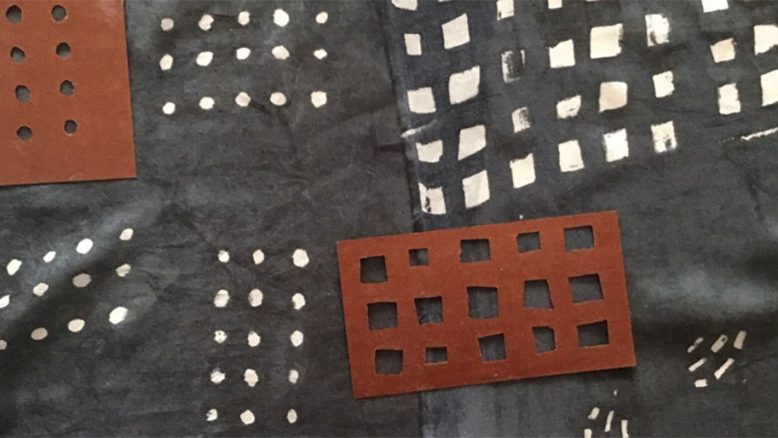The last month has been very exciting for me, though I am easily pleased. At the beginning of the month I took my first Zoom workshop with the highly recommended sarahdesmarais.com. This was a workshop in katazome, Japanese rice paste resist dyeing. Sarah had made up a pack of materials for us to use, including the incredibly sticky rice paste made from defatted bran and sweet rice. It keeps in the fridge for some time and I have plenty to use up in the next few weeks.
We had the traditional, and eye wateringly expensive, stencil paper traditionally made in Japan that is waterproof, reusable and lovely to handle. It is layers of mulberry paper glued together, then treated with persimmon juice. We drew our designs on the paper, carefully cut them out with a very sharp scalpel, then applied the paste. The paste dried over lunchtime and then we used thickened dye to roll across our fabric (fine silk in this instance), wrapped and microwaved the stencilled fabric then had the excitement of washing the paste out and seeing if it had worked.
I made the rookie mistake – very silly for one who has been applying dye to fabric in various ways for 40 years or so – of not ensuring the faces of the fabric were properly separated and so my little samples aren’t as crisp and I’d like. However, I have paste, stencils, fabric and dye, so watch this space.
My next trick has been to join an online shibori class with Jane Callender, https://janecallender.com, again very highly recommended. I have dabbled in shibori for years but thought this was a time to try and do it properly. Jane is teaching at the AFWSD Summer School next year and so am I, so I couldn’t take her course. This is an excellent opportunity to improve my rather haphazard skills. Like many things in life, shibori is fairly easy to do, far harder to do well.
Sadly, in the silk moth department, I have no Japanese Oak Silkmoths this year but the last batch of Eri caterpillars are spinning , somewhat haphazardly, but as they hatched at different rates so they will reach the size that makes them capable of spinning at different times. This lot have a marked tendency to wander about and I have found them settling down to spin in the most unexpected places – on my shibori stitched fabric, on a bit of stencil card and on the table. I just wait till they’ve finished and then move them, though it does mean I am often unable to do the task I had intended to.
Today the postman brough me a delightful and unexpected package – a box of assorted spinning fibres. Along with several UK friends I belong to the Landelijke Spingroep, in The Netherlands. There is usually a grand get together in October but of course, circumstances have made that impossible this year. There will be a virtual meeting and we have all been sent a lovely set of fibres from different sheep to try. Several of them are new to me so I’m really looking forward to finding out how they are best spun and what sort of end product they might be good for.
Weaving is going well, too. Once again, I have a wonderful opportunity to take part in an online course with Laura Thomas, https://www.laurathomas.co.uk. Laura is a regular tutor at Peter Tavy Guild of Weavers, Spinners and Dyers and sadly this year we missed her workshop. However, she has taken to online teaching and it’s wonderful that she is accessible in this way. This workshop would have been held in London, in person, and I would not have had the opportunity to take it, so the current situation has one or 2 silver linings.
I have plenty to keep me going over the next few weeks, including some dye research, so I won’t be bored.

